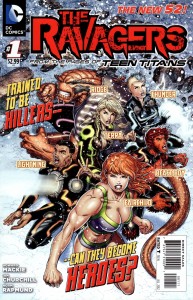 Last September, DC Comics rebooted their entire universe, with the stated purpose of making each and every one of their books accessible to readers who had never read any of their books before. It is now June, and DC Comics has released The Ravagers #1, and apparently their commitment to making books accessible to readers unfamiliar with existing continuity lasted almost exactly ten months.
Last September, DC Comics rebooted their entire universe, with the stated purpose of making each and every one of their books accessible to readers who had never read any of their books before. It is now June, and DC Comics has released The Ravagers #1, and apparently their commitment to making books accessible to readers unfamiliar with existing continuity lasted almost exactly ten months.
The Ravagers is a superteam introduced in the latest few issues of Teen Titans, which I haven’t been following as closely as I perhaps should be because it started as a decompressed and slow paced riff on The X-Men and became, well, a decompressed and slow paced riff on The X-Men. Well, apparently somewhere around Teen Titans ninth issue, they introduced The Ravagers, victims of the fiendish plot of shadow organization N.O.W.H.E.R.E. to activate the metagenes of unsuspecting teenagers and to force innocent comics writers to type longassed acronyms.
The Ravagers are a collection of what amounts to the B Team second stringers from the old DC Universe, only with new origins, a set of new costumes comprised of what seems like 70 percent neon (and about 200 percent of the neon most reasonable non-MIT students would integrate into clothing), and a baaaad attitude. Yes, a bad attitude, as they all seem to have the same one.
This book opens with the tail end of an escape from N.O.W.H.E.R.E. (an escape we don’t get to see) to somewhere in Alaska for some reason we’re never told, with a stack of characters who might be familiar to 80s and 90s Teen Titans fans, but even if they are, they won’t be by look alone. Even fucking Beast Boy, who has as iconic a look as anyone in DC Comics, is reimagined as being red rather than green. Why? Fucked if I know; maybe green ink’s more expensive.
We’re introduced to a ton of characters here, and the problem is that they are all just too damn similar for any of them to stand out. Everyone except for Fairchild is shown as a snarling, sarcastic and angry, with either raging cases of body dysmorphia or bizarre exhibitionist streaks that are somewhat inappropriate for Alaska in midwinter. Fairchild, however, is different; shown as roughly 25 percent Den Mother, 30 percent responsible adult, and 45 percent pure story exposition. What we do know about the characters and why things are happening come mostly from voice over captions from Fairchild. Which allows writer Howard Mackie to keep us from being completely lost, but it’s not the most exciting way to present a story.
The biggest problem here is that this issue requires – no, demands – that you be following at least Teen Titans and maybe Superboy in order to have any real idea as to what’s going on and why. These kids had something bad happen to them, but we’re never specifically told what it was. Some of them have prior relationships, but they aren’t elaborated upon. They are being hunted by N.O.W.H.E.R.E., but why are they being killed instead of captured? How the fuck should I know? The fact of the matter is that the background needed to answer those questions is in other books.Books written by Scott Lobdell. And making reading those books a prerequisite to understanding this one seem less a hurdle than a punishment.
Ian Churchill’s art is perfectly solid in a very 90s style, which is appropriate considering this is a very 90s comic. His stuff is fine lined and detailed, with good facial expressions, even though most of them are of the 90s Image snarling variety. And, as in any “good” 90s comic, Churchill gives up the standard goods: chicks in battle suits, inhuman monsters with pointed teeth, tails and neck cords, chicks with swords, monsters with claw fingers, and chicks with snarls, neck cords and swords. This kind of thing isn’t to my general taste, but it is what it is: competent, if overly stylized.
This book is, in almost every way, a throwback. It is a shallow, 90s style team book that is not only continuity hobbled and character challenged, but for a book only in the second wave of DC’s New 52 initiative – one designed to make books more accessible – this book is, instead, impenetrable, favoring style over substance. Give it a pass.
 Podcast RSS Feed
Podcast RSS Feed iTunes
iTunes Google Play
Google Play Stitcher
Stitcher TuneIn Radio
TuneIn Radio Android
Android Miro Media Player
Miro Media Player Comics Podcast Network
Comics Podcast Network